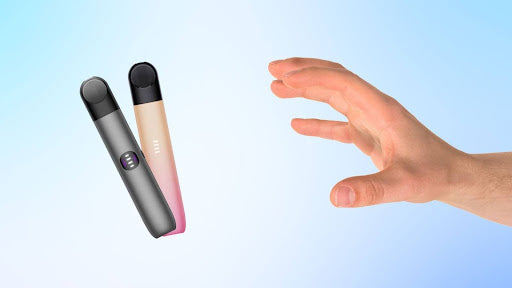Can You Use Any E-Liquid in Any Vape Pen?
One of the most common questions a new vaper may have is whether you can use any e-liquid in any vape pen.
Unfortunately, many newcomers will mistakenly believe that e-liquids are universally compatible with vapes. However, the wrong e-liquid leads to potentially clogged coils, leaky tanks and a compromised vaping experience.
In this guide, we’ll cover the various e-liquid types and which are best suited for you, depending on your device. Also, you’ll know what your vape juice is made of, so you can find the perfect match.
E-Liquid Types
If you’ve been researching vape juices, you may have noticed that they come in various ratios, which refers to the amount of propylene glycol (PG) and vegetable glycerin (VG) present in the e-liquid.
The first number refers to the percentage of VG, while the second number after the slash represents the percentage of PG.
For instance, a bottle of e-liquid stating a ratio of 70/30 means there’s 70% VG and 30% PG. The PG and VG ratio affects your vaping experience, impacting flavour intensity, vapour production, and smoothness.
PG E-Liquids
PG e-liquids are bottles that contain mostly propylene glycol and come in higher nicotine levels.
These liquids usually contain at least 60% PG and are designed to mimic the feeling of smoking rather than producing large clouds. High PG liquids are best when vaped using lower temperatures, and you’ll see more of an effect from the nicotine content than with other types of e-liquid.
Generally, PG e-liquids are less practical for devices with powerful heating elements or large wicking channels like advanced mods. Instead, they’re better utilized on vape pens or mouth-to-lung (MTL) devices. Vape pens have smaller interior components like wick openings for more focused vapour production.
VG E-Liquids
In VG-based e-liquids, vegetable glycerin typically makes up 60% or more of the e-liquid. The amount of vegetable glycerin helps to produce thicker clouds that pack a bigger punch. The most common ratio for VG-based juices is 70/30 and goes up to 6 mg of nicotine.
The higher VG content is best suited for devices that accommodate the thicker consistency, such as sub-ohm tanks and advanced mechanical mods.
Sub-ohm tanks can vapourize high VG e-liquids more efficiently to produce intense flavours. The thicker and more viscous nature of the liquid makes it too dense for older types of atomizers.
Shortfills
Shortfill vape juices are large bottles of e-liquid that are nicotine-free. Unlike other e-liquids, the bottles aren’t completely filled, leaving a gap for you to fill with nicotine shots. As a result, you can personalize your vape experience to the desired nicotine strength.
Shortfills may be common for heavy users. In an attempt to discourage high nicotine consumption in younger people, Canada regulations have set a maximum nicotine concentration of 20 mg/mL in vaping products. If you want a higher concentration, shortfills are used and filled with nicotine shots.
50/50 Vape Juice
50/50 vape juice is just what it sounds like – 50% propylene glycol and 50% vegetable glycerin. PG is more intense and carries flavours better, while VG produces a denser, thicker cloud, adding sweetness.
The idea is to balance the qualities and create a well-rounded vaping experience.
50/50 vape juices are great for people who use pod systems since they have smaller wick openings and coils. The high PG content means there’s a thinner consistency, allowing the liquid to flow more easily through the device and vapourize. Vapers typically use 50/50 juice in advanced high-performance vapes with a high atomizer resistance.
What Do Vape E-Liquids Contain?
If you’re a vaper, you should know about the contents inside e-liquids to understand how it impacts your experience and to know what you’re inhaling into your body.
Here are the most common ingredients found in vape e-liquids:
- Vegetable Glycerin (VG): Vegetable glycerin is a sweet-tasting viscous liquid derived from vegetable oils to create thicker and smoother vapour. Vegetable glycerin is a sugar alcohol, which is why it has a sweet taste, similar to sugar substitutes.
- Propylene Glycol (PG): Propylene glycol is a watery solution that serves as a base liquid for vape juices. These liquids are runnier than VGs, They take less power and vapourize quickly. It also helps to carry the flavour and nicotine.
- Nicotine: The nicotine levels in vape juices vary significantly — from nicotine-free options to some as potent as up to 36 mg/ml or more. Nicotine is a highly addictive compound found in tobacco plants.
- Food-grade Flavouring: Vape juices contain a combination of artificial and natural ingredients to alter the taste of the vape. It can come in various fruity, savoury, tobacco or dessert-like flavours.
Can Vape Juice Go in Any Vape?
No, not all vape juices are compatible with every type of vape device. Several factors at play impact the compatibility between the device and e-liquid.
For example, a box mod contains a sub-ohm coil and a powerful battery, allowing the pen to heat and vapourize easily.
Using a high PG e-liquid would cause overheating, which increases the chance of leaking and causes an unsatisfying experience. Instead, these devices require vape juices with higher VG content for optimal performance.
Another factor to consider is coil compatibility. Some e-liquid types may be too thick for coils with small openings, causing dry hits. That’s because the e-liquid doesn’t flow properly to the coil, causing the wick to burn.
For mouth-to-lung vaping, the devices use a coil resistance of 1.0 Ohms or more, which pairs well with high PG e-liquids for a smooth intake.
Explore High-Quality E-Liquids With RELX
Knowing all the facts about vape juices and which ones are the perfect match for your device is essential.
Knowing about the various e-liquid types and their ingredients allows you to find the best ratio to maximize your vaping experience.
If you’re exploring the best options for vape devices, RELX is a trusted brand that offers a wide selection of vape devices to suit your taste preferences and tolerance for nicotine.
Also in Vape Knowledge

Quick Fixes for a Burnt Vape Taste

Are Vapes Allowed in Checked Luggage?













